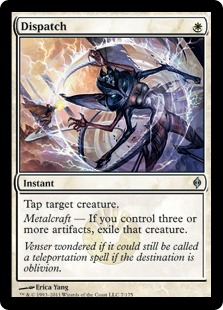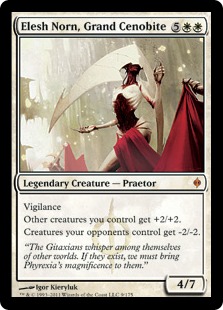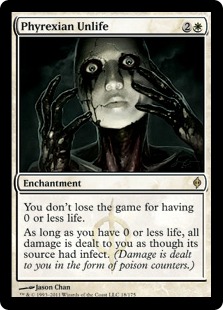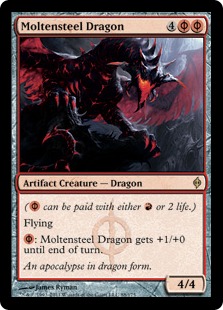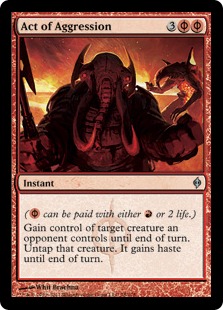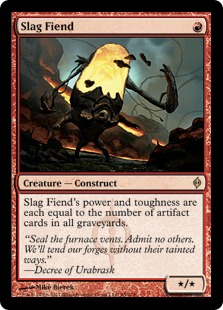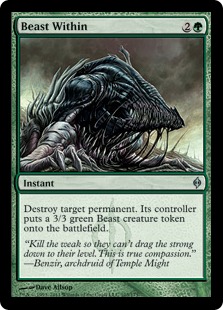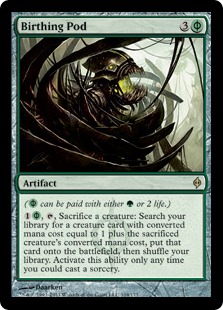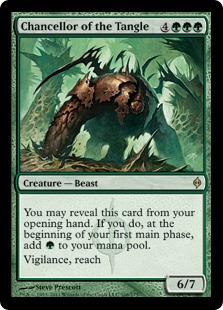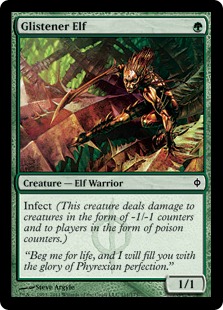This week, I’ll be going in depth on New Phyrexia’s potential Legacy applications. Although Legacy is a format of over 10,000 cards, most
cards are better versions of one another, and so this won’t be a comprehensive set review. I’d rather give more attention to the potential
upsides of a few cards than tell you that Loxodon Convert won’t really cut it in Junk.
I’ve picked three cards from each color that I think will prove particularly promising in Legacy. I’ll walk you through what I see as their
potential applications, where they fit into existing archetypes, and what archetypes could get pushed over the top by a new addition.
Today, I’ll be looking at white, red, and green cards.
White
First up is Dispatch:
Dispatch is the third-best W instant-speed removal spell in Legacy behind Swords to Plowshares and Path to Exile, but I think it still has a few
potential homes. Since we’re looking for decks that can metalcraft consistently, it makes sense to start with Affinity:
Creatures (28)
- 4 Arcbound Ravager
- 4 Myr Enforcer
- 4 Frogmite
- 4 Disciple of the Vault
- 4 Ornithopter
- 2 Memnite
- 2 Etched Champion
- 4 Signal Pest
Lands (12)
Spells (20)

The first question that any deck designer should ask is “Well, why does Affinity need a removal spell, anyway? Don’t we have Disciple of
the Vault and Tezzeret, Agent of Bolas and a million other ways to not care about blockers?” It’s a good question. The problem is that
Signal Pest Affinity has a lot of openers that involve multiple zero-mana creatures that don’t really do much if we’re chump
attacking with one of our guys every turn. This weakness, though, is more than made up for by the fact that Signal Pest is a huge clock that pumps out
a lot of damage faster than most control decks can handle.
A major issue that Affinity decks often encounter is the presence of a roadblock. It can be Tarmogoyf, Knight of the Reliquary, or even Grim
Lavamancer, but it’s usually a creature. What Dispatch does that Tezzeret, Agent of Bolas or Galvanic Blast or Disciple of the Vault
doesn’t do is let you get through multiple attacks without your strike force getting ripped apart by a fat blocker.
“But what about Galvanic Blast? Four damage is a lot nowadays and having access to reach is good in an aggressive deck like Affinity,
right?” Well, Galvanic Blast is fine for most tasks, but Affinity tends to produce very large, opposing Tarmogoyfs. I’d also never expect
Galvanic Blast to off an opposing Knight of the Reliquary, which can be a huge problem for this deck. Etched Champion helps with this to a degree, but
having a way to actually kill their guy is important.
The reason why Swords to Plowshares and Path to Exile never saw much play in Affinity is that their drawbacks were actually too severe. Path to Exile
is the most egregious offender, since Affinity as a mechanic is unfair because of its speed, not its raw power. At the end of the day, you’re
still casting 1/1s, 0/2s, 2/2s, and 4/4s—you’re just casting them all on turns one and two. If you accelerate your opponent into their
midgame, they get to play their cards on a timeline that resembles yours that much more. Pathing their Tarmogoyf seems great until they untap, Green
Sun’s Zenith for another Tarmogoyf, and Swords to Plowshares your Signal Pest.
Swords to Plowshares is a little closer, but you’re still Time Walking yourself with your removal spell. Letting them gain three or four or five
life is almost certainly going to be another turn that they can live to draw the removal spell that wrecks your position or the replacement creature
that stabilizes the board. Dispatch, on the other hand, just removes their guy. No life, no land, just gets his guy out and your guys in.
Â
Next up, we have Elesh Norn, Grand Cenobite:
Last week, Richard Feldman wrote the best Dredge primer I’ve ever read. I encourage you to read it if you missed it somehow. In
it, he advocates for the inclusion of Elesh Norn as a two-of in his sideboard. As a fan of Crovax, Ascendant Hero, this was a card I could get behind.
Of course, we aren’t going to be paying retail for this, so let’s start figuring out where it can go.
The best relevant ways to cheat on casting costs in this format are Reanimate, Exhume, Animate Dead, Show and Tell, Dread Return, and Eureka. Of
course, this is not the first fatty with a bunch of sweet abilities that Wizards has created, so there’s a fair bit of overlap in terms of what
roles Elesh Norn is best at playing.
We’ll almost always want this against aggressive decks, since the Infest side of Norn is going to swing many more games than a double Glorious Anthem.
The best stand-alone anti-aggro fatties in Magic are Sphinx of the Steel Wind, Grave Titan, and Blazing Archon. So how does Elesh Norn stack up against
the competition?
Elesh Norn is going to do better than all the other options when faced with small creatures that can kill you or remove Elesh without attacking. If all
we want is a Moat and don’t care about any sort of removal, we have Blazing Archon. If we want to be able to stop multiple large attackers
through a removal spell, we want Grave Titan. If we want to be able to evade certain types of removal, we have Sphinx of the Steel Wind. Against
Dredge, Elves, Goblins, and Merfolk, though, Elesh Norn stops their Zombie tokens, Heritage Druid, Siege-Gang Commander, and Sower of Temptation. There
will be moments where an opponent has Emrakul or Knight of the Reliquary, and I’ll want Blazing Archon or Sphinx of the Steel Wind, but for the
most part, I believe that Elesh Norn will supplant Blazing Archon as the Moat-creature of choice in Legacy.
Â
Finally, we have Phyrexian Unlife.
A lot of people have asked me about its viability in an Ad Nauseam shell, since Ad Nauseam causes you to lose life and thus won’t give you any
poison counters. It’s possible, but so is Angel’s Grace + Ad Nauseam. That doesn’t mean that it’s unplayable by any means.
After all, one of the biggest problems that Ad Nauseam Tendrils decks have is that they care about their life total. Every attack step that an opponent
gets weakens their draw power. Your Ad Nauseam from 20 life will almost always get there. Your Ad Nauseam from 3? Probably not.
But what if we could play a card that completely eliminates the drawback of Ad Nauseam and gains us ten life? That would be worth considering.
Orim’s Chant and Silence have always been playable in this deck, so adding white wouldn’t really be that bad, either. You could play a more
High Tide—like game, using your life total as a resource to buy more turns, going below zero and accruing poison counters, only to untap with
eight poison and negative two life, Silence them, and draw your deck. Seems a lot better than Angel’s Grace now, doesn’t it?
But that’s not the only application of Phyrexian Unlife. At its core, it’s also a straight-up Delusions of Mediocrity. If any deck is in
the market for ten more points of life, this is where they can find it. In fact, it’s actually a better Delusions of Mediocrity since you can
play it at ten life or less and not immediately lose when they bounce or destroy it with the trigger on the stack. It can’t be Red Elemental
Blasted or Stifled, either.
It doesn’t end there, either. Phyrexian Unlife specifies damage, as opposed to loss of life. The terms are close, but they aren’t the same
thing—all damage is loss of life, but not all loss of life is damage. The practical upshot of this wording is that, with Phyrexian Unlife in
play, you’ll never lose to Tendrils of Agony or your own Dark Confidant. Just keep in mind that you can’t pay life if you don’t have any,
so those Force of Wills and fetchlands are going to be pretty bad for you once you dip into poison territory.
Red
I’m going to shoot straight with you guys here: red is not the primary beneficiary of New Phyrexia’s riches. In fact, the three red cards
most likely to make a major impact in Legacy will very likely see the most success in decks with few—if any—ways of producing red mana.
First up, we have Moltensteel Dragon.
My first instinct was to put this in Dragon Stompy. It competes with Rakdos Pit Dragon for room in the “four-drop Dragon with
firebreathing” slot, but if you wanted to make a Red Chalice deck that didn’t want to go Hellbent all the time, Moltensteel could be
exactly what you want. Having the ability to pseudo-Hatred kill them is appealing, even more so when Seething Song is in the deck to reduce how much
life we need to pay.
The real place where this guy could shine is in an all-in deck that employs Berserk and Assault Strobe to really go all-in. A rough sketch:
Creatures (12)
Lands (16)
Spells (32)

This deck is pretty soft to Mental Misstep, but it does have a lot of ways to kill an opponent on turn two or turn three. There are a lot of other ways
to look at a Moltensteel Dragon, but it feels very much like Hatred to me.
Â
Next up, we have Act of Aggression.
Act of Aggression is a near-reprint of Ray of Command, just without all that pesky blue mana. Having an instant-speed, colorless Threaten is pretty
ridiculous in any format with creature combat, and modern Legacy is no exception. Regardless of where it might see play, though, I just don’t see
paying five mana for it all that often. As a result, I’m not convinced that playing it in a red deck would give you much value over finding room
for it in, say, a green deck.
Act of Aggression is a split card. One half of it reads like a removal spell: you take one of their guys in their attack step, block their other guy,
and hopefully bin both of them. A three-mana, four-life Twinstrike. Not too bad. There are definitely decks that want something like that. After all,
isn’t the Merfolk mirror all about Lord advantage? Seizing their Merrow Reejerey mid-combat seems like a filthy sort of Zealous Persecution.
I’m not sure it’s better than just casting Llawan, Cephalid Empress, but it could be very potent. A better example might be the Goblins
mirror, where there are fewer lords—just Goblin Chieftain, really—but having 2/2s fighting 1/1s is going to end in a massacre every time.
Again, I’m not certain that it’s better than just having your own Chieftain, but I can see situations where this could provide more
flexibility and utility across various matchups.
The other half of Act of Aggression is that it’s a great alpha strike card. In a game state like the Junk mirror, where you have Tarmogoyfs and
Knights of the Reliquary staring at each other, having the ability to take one of their Knights and send your squad for a ton of damage seems very
strong. Really, though, any deck that gets bottlenecked by one big blocker could do a lot worse than turn to an Act of Aggression to push through a lot
of crucial damage out of nowhere.
Â
Finally, speaking of alpha strikes, we have Slag Fiend.
Slag Fiend is another contender for a slot in an Affinity decklist. I’ve already given Affinity its fair share of space, but it’s important
to note that there can be very different flavors of Affinity. The most recent versions have been Signal Pest Affinity, in the style of Lukas Parson and
Blake McCracken. Prior to those innovators, however, Affinity was a fairly straightforward artifact creature attack deck with Disciple of the Vault,
Thoughtcast, and Blinkmoth Nexus for nonartifacts.
Slag Fiend could be another sort of Cranial Plating. Granted, it’s a reverse Cranial Plating, but it works rather well with Arcbound Ravager and
Disciple of the Vault’s modus operandi of binning your board to kill the enemy. As a late-game threat, Slag Fiend can easily come down as a 10/10
after a protracted attrition war. It’s strong at almost every stage of the game and offers an opponent any number of ways to miscount your
deck’s damage potential in an attack step.
The reason why it wouldn’t do to just jam Slag Fiend into the Signal Pest version of Affinity is that that version of the deck doesn’t
value each of its cards as being worth one card. Its Signal Pests are worth a lot more than one card, while its Ornithopters and Memnites are nearly
worthless without a Cranial Plating or Signal Pest. If the Ancient Dens, Etched Champions, Signal Pests, Memnites, and Dispatches become Great
Furnaces, Slag Fiends, Masters of Etherium, Arcbound Workers, and more Blinkmoth Nexuses, you have a completely different deck. It’s still
Affinity, but it’s prepared to fight a longer game against a more removal-heavy metagame. It has Arcbound Ravager to sidestep a single point
removal spell, Master of Etherium and Slag Fiend as must-kill creatures, and Disciple of the Vault plus Ravager as built-in inevitability. The deck is
very different, but then, so is the strategy.
Green
Green got a lot of sweet cards in New Phyrexia, so I cheated with this section. There are actually four green cards in the set that I think will impact
the format. Sorry, guys.
First up is Beast Within.
Beast Within does a lot of things that green decks have never had access to before, and they’re going to be relevant for and against every type
of deck in the format. Having the ability to blow up lands isn’t too new—see Thermokarst and Ice Storm—but killing creatures and
planeswalkers definitely is. The versatility of having it be an instant is just icing on the cake.
My first thought was how much this helps Elf Combo against cards like Grim Lavamancer and Dark Confidant. They don’t really care about the 3/3,
since they’re focused on going exponential with their mana production and card drawing to create an unbeatable board state. Granted, having a
three-mana noncreature in a deck with Glimpse of Nature isn’t the greatest thing ever, but it sure beats folding to a turn one Grim Lavamancer.
My next thought was how good it is in a Counterbalance war. It reminds me of Vendilion Clique in its functionality—three mana, instant-speed,
three power, has the ability to off their Jace, and (sort of) offers the option to upgrade one of your suboptimal cards. On an empty board against
Jace, you could just activate one of your Tops on their end step, respond by upgrading it to a Beast, draw your card, and kill their Jace. Of course,
if you’re in a Tarmogoyf stalemate, you could just kill their Goyf…
From there, I thought of its applications in any sort of combo deck. If you’re playing Natural Order/Show and Tell, Beast Within is a Krosan Grip
that kills their Gaddock Teegs and Knights of the Reliquary. If they raw-dog their Karakas, so much the better—just give them a 3/3 and Show them
your 15/15.
Really, though, this is a green Vindicate with zero downside. Green decks in Legacy have almost never cared about a 3/3 and certainly have had no cause
to care about 3/3s recently. The format has gotten pretty unfair, and green decks have gotten somewhat left behind in that arms race. Beast Within
offers green a way to claw back into that fight from a very different angle.
Â
Next up, we have a much more linear card: Birthing Pod.
Birthing Pod reminds me of Food Chain. Food Chain is an innocuous enchantment that was singlehandedly responsible for the banning of Goblin Recruiter.
The basic idea was that you cast Goblin Recruiter on turn two, stacked your deck with a bunch of Goblins such that Goblin Ringleaders were every fourth
card, and passed. The next turn, you cast Food Chain, sacrificed your Recruiter for a three-mana Goblin, sacrificed that one for the Ringleader you
just drew, and flipped a bunch of Goblins off the top of your library by chaining Ringleaders. You netted four mana in the process, which you would use
to upgrade your creatures into Siege-Gang Commanders, which each netted four mana. You would cast a Goblin Warchief, cast all four Goblin Piledrivers,
and attack for a lot of damage on turn three.
Birthing Pod needs its Goblin Recruiter, so to speak. If we’re playing fair, Birthing Pod is a perfectly reasonable card, but it’s nothing
to write home about. I could see playing it in an aggressive Elves deck that plays four Sylvan Messengers, but that’s still playing fair.
Upgrading Goblin Matron into Goblin Ringleader is cute, but it’s not winning. This is a card that does almost everything broken in
Legacy: it’s a colorless artifact, it puts creatures in your graveyard, it tutors creatures from your deck directly into play, and it can do so
on the turn it enters play. I don’t have the answer for you, but there has to be a way to use Birthing Pod as a four-mana, four-life way of
effectively ending the game. Of all the cards in New Phyrexia, Birthing Pod is the puzzle that contains the most promise and potential for Legacy
power. This card will see play in a very powerful deck in the near future.
Â
Speaking of very powerful decks, Chancellor of the Tangle may well have put an old Extended favorite over the top:
Chancellor of the Tangle is another split card, of sorts. On one hand, it’s a conditional Elvish Spirit Guide. On the other hand, it’s a
bigger Jungle Weaver. No prizes for guessing which side we want to be abusing.
The scuttlebutt going around the internet is that this card marks the coming of Hypergenesis to Legacy. Prior to Chancellor, Hypergenesis had eight
Spirit Guides, a fragile mana base, and more absurd boom-booms than it knew what to do with. So how does Chancellor provide the deck with any sort of
help?
I think the deck will change. Chancellor gives you green mana only, and I would assume you’re not cutting Elvish or Simian Spirit Guides for a
Leyline of Elvish Spirit Guide. Given that the deck currently cascades with Ardent Plea and Violent Outburst, it’s impossible for Chancellor to
assist in casting a turn one Ardent Plea. This means that you need to open on a Chancellor, Outburst, land, and Spirit Guide to “live the
dream.”
I think we can do a little better. If we play Eureka, Outburst, and Show and Tell instead of Ardent Plea, we can construct our deck to be a more
dedicated U/G cheats strategy. If that’s the case, we can afford to play up to eight Sol Lands: Ancient Tomb and City of Traitors. This land
configuration will let us live the Chancellor, Spirit Guide, land, Cheat dream more often. To give you a starting point:
Creatures (27)
- 4 Elvish Spirit Guide
- 1 Sakashima the Impostor
- 2 Angel of Despair
- 4 Simian Spirit Guide
- 4 Progenitus
- 4 Sphinx of the Steel Wind
- 4 Emrakul, the Aeons Torn
- 4 Chancellor of the Tangle
Lands (13)
Spells (20)

I have no illusions that any of these numbers are correct, but if you’re going to be Tangling, you may as well do yourself a favor and figure out
how to cut Ardent Plea. You can certainly play a more traditional Hypergenesis deck with full sets of Plea, Show, and Outburst, but if you have access
to Eurekas, I’d definitely give this build a spin first.
Â
Finally, although I wrote
an entire article
on Glistener Elf, I couldn’t possibly let a set review of New Phyrexia Green go by and not mention it.
Someone is going to get poisoned by this card in the next month. Infect decks have wanted a one-drop since Scars; they got their one-drop, and
they’re going to exist. They may be fragile, and Phyrexian Crusader may be a necessary maindeck card, but Pump Infect is going to be Real.
Don’t say I didn’t warn you.
Check back with me on Thursday for the second half of my New Phyrexia Legacy review. I promise I won’t talk about Mental Misstep for the entire
article.
Good luck with your brewing!
Drew Levin
@mtglegacy on Twitter

